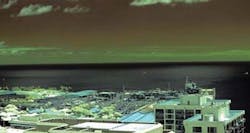Air Force takes aim at short-wave infrared cameras for widespread use in military programs
Officials of the U.S. Air Force Research Laboratory at Wright-Patterson Air Force Base, Ohio, have issued a broad agency announcement (BAA-RQKM-2014-0006) for the Industrial Base for Low Cost Shortwave Infrared (SWIR) Camera Cores program.
This electro-optics initiative seeks to make SWIR camera technology ready for widespread program insertion and acquisition; to increase SWIR camera performance while reducing its cost to less than $5,000 per item (not including optics); and to expand SWIR camera manufacturing capabilities to be more responsive to U.S. Department of Defense (DOD) needs.
Related: Navy chooses SWIR camera from Sensors Unlimited for day/night sight sensor research
The effort seeks to establish a merchant supplier base not only for SWIR camera cores, but also for sensors, packaged and unpackaged focal plane arrays, wafers, and other SWIR sensor components. SWIR imaging capability has demonstrated needed military capability but is unaffordable to the warfighter at present, researchers say.
SWIR cameras produce images of light wavelengths from 0.9 to 1.7 microns. Unlike long-wave infrared thermal-imaging cameras, SWIR cameras cannot produces images in total darkness. SWIR images particularly are effective in pulling detail out of deep shadows, and can see through windows.
An atmospheric phenomenon called night sky radiance emits five to seven times more illumination than starlight, nearly all of it in the SWIR wavelengths. A SWIR camera and this night glow can see objects with great clarity on moonless nights and share these images across networks. SWIR cameras also are effective at helping warfighters see through fog, smoke, and haze.
Air Force Research Lab officials say they expect to award one contract for this program worth about $4.6 million. Most of the work will be in 2014 and 2015. A contract should be awarded this spring.
Related: Electro-optical sensor payloads for small UAVs
Companies interested should respond no later than 11 Feb. 2014. For technical questions contact the Air Force's Theodore Finnessy by phone at 937-904-4344, or by email at [email protected]. For contracting questions contact Jimmie Garrard by phone at 937-656-9744, or by email at [email protected].
More information is online at https://www.fbo.gov/spg/USAF/AFMC/AFRLWRS/BAA-RQKM-2014-0006/listing.html.
